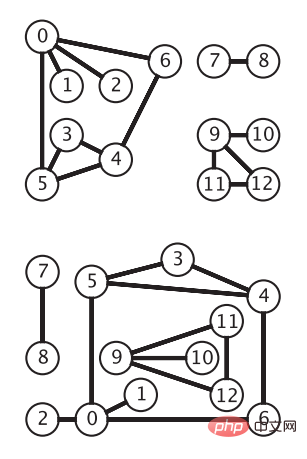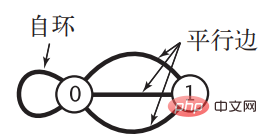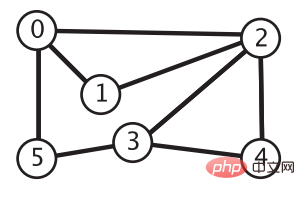How to implement an undirected graph in Java?
Basic concepts
Definition of graph
A graph is composed of a point set V={vi} A tuple consisting of a set E={ek} of unordered pairs of elements in VV is recorded as G=(V,E), and the element vi## in V # is called a vertex, and the element ek in E is called an edge.
For two points u, v in V, if the edge (u, v) belongs to E, then the two points u and v are said to be adjacent, and u and v are called the endpoints of the edge (u, v) . We can use m(G)=|E| to represent the number of edges in graph G, and n(G)=|V| to represent the number of vertices in graph G. Definition of undirected graphFor any edge (vi, vj) in E, if the endpoints of the edge (vi, vj) are unordered, it is an undirected edge. At this time Graph G is called an undirected graph. Undirected graph is the simplest graph model. The following figure shows the same undirected graph. The vertices are represented by circles, and the edges are the connections between vertices without arrows (picture from "Algorithm 4th Edition"):
package com.zhiyiyo.graph;
/**
* 无向图
*/
public interface Graph {
/**
* 返回图中的顶点数
*/
int V();
/**
* 返回图中的边数
*/
int E();
/**
* 向图中添加一条边
* @param v 顶点 v
* @param w 顶点 w
*/
void addEdge(int v, int w);
/**
* 返回所有相邻顶点
* @param v 顶点 v
* @return 所有相邻顶点
*/
Iterable<Integer> adj(int v);
}ij)n×n , where:

A to implement the adjacency matrix. When A[i][j] = true, the vertex i and j are adjacent.
2 Boolean values, which will cause a lot of waste for sparse graphs. When the number of vertices When it is very large, the space consumed will be an astronomical figure. At the same time, when the graph is special and has self-loops and parallel edges, the adjacency matrix representation is powerless. "Algorithm" gives graphs with these two situations:

Edge, only two instance variables are used to store the two vertices u and v, and then all Edge can be saved in an array. There is a big problem with this, that is, when obtaining all adjacent vertices of vertex v, you must traverse the entire array to obtain them. The time complexity is O(|E|). Since obtaining adjacent vertices is a very common operation, This way of expressing it doesn't work either.

package com.zhiyiyo.graph;
import com.zhiyiyo.collection.stack.LinkStack;
/**
* 使用邻接表实现的无向图
*/
public class LinkGraph implements Graph {
private final int V;
private int E;
private LinkStack<Integer>[] adj;
public LinkGraph(int V) {
this.V = V;
adj = (LinkStack<Integer>[]) new LinkStack[V];
for (int i = 0; i < V; i++) {
adj[i] = new LinkStack<>();
}
}
@Override
public int V() {
return V;
}
@Override
public int E() {
return E;
}
@Override
public void addEdge(int v, int w) {
adj[v].push(w);
adj[w].push(v);
E++;
}
@Override
public Iterable<Integer> adj(int v) {
return adj[v];
}
}package com.zhiyiyo.collection.stack;
import java.util.EmptyStackException;
import java.util.Iterator;
/**
* 使用链表实现的堆栈
*/
public class LinkStack<T> {
private int N;
private Node first;
public void push(T item) {
first = new Node(item, first);
N++;
}
public T pop() throws EmptyStackException {
if (N == 0) {
throw new EmptyStackException();
}
T item = first.item;
first = first.next;
N--;
return item;
}
public int size() {
return N;
}
public boolean isEmpty() {
return N == 0;
}
public Iterator<T> iterator() {
return new ReverseIterator();
}
private class Node {
T item;
Node next;
public Node() {
}
public Node(T item, Node next) {
this.item = item;
this.next = next;
}
}
private class ReverseIterator implements Iterator<T> {
private Node node = first;
@Override
public boolean hasNext() {
return node != null;
}
@Override
public T next() {
T item = node.item;
node = node.next;
return item;
}
@Override
public void remove() {
}
}
}
package com.zhiyiyo.graph;
public interface Search {
/**
* 起点 s 和 顶点 v 之间是否连通
* @param v 顶点 v
* @return 是否连通
*/
boolean connected(int v);
/**
* 返回与顶点 s 相连通的顶点个数(包括 s)
*/
int count();
/**
* 是否存在从起点 s 到顶点 v 的路径
* @param v 顶点 v
* @return 是否存在路径
*/
boolean hasPathTo(int v);
/**
* 从起点 s 到顶点 v 的路径,不存在则返回 null
* @param v 顶点 v
* @return 路径
*/
Iterable<Integer> pathTo(int v);
}深度优先搜索
深度优先搜索的思想类似树的先序遍历。我们从顶点 0 开始,将它的相邻顶点 2、1、5 加到栈中。接着弹出栈顶的顶点 2,将它相邻的顶点 0、1、3、4 添加到栈中,但是写到这你就会发现一个问题:顶点 0 和 1明明已经在栈中了,如果还把他们加到栈中,那这个栈岂不是永远不会变回空。所以还需要维护一个数组 boolean[] marked,当我们将一个顶点 i 添加到栈中时,就将 marked[i] 置为 true,这样下次要想将顶点 i 加入栈中时,就得先检查一个 marked[i] 是否为 true,如果为 true 就不用再添加了。重复栈顶节点的弹出和节点相邻节点的入栈操作,直到栈为空,我们就完成了顶点 0 可达的所有顶点的遍历。
为了记录每个顶点到顶点 0 的路径,我们还需要一个数组 int[] edgeTo。每当我们访问到顶点 u 并将其一个相邻顶点 i 压入栈中时,就将 edgeTo[i] 设置为 u,说明要想从顶点i 到达顶点 0,需要先回退顶点 u,接着再从顶点 edgeTo[u] 处获取下一步要回退的顶点直至找到顶点 0。
package com.zhiyiyo.graph;
import com.zhiyiyo.collection.stack.LinkStack;
import com.zhiyiyo.collection.stack.Stack;
public class DepthFirstSearch implements Search {
private boolean[] marked;
private int[] edgeTo;
private Graph graph;
private int s;
private int N;
public DepthFirstSearch(Graph graph, int s) {
this.graph = graph;
this.s = s;
marked = new boolean[graph.V()];
edgeTo = new int[graph.V()];
dfs();
}
/**
* 递归实现的深度优先搜索
*
* @param v 顶点 v
*/
private void dfs(int v) {
marked[v] = true;
N++;
for (int i : graph.adj(v)) {
if (!marked[i]) {
edgeTo[i] = v;
dfs(i);
}
}
}
/**
* 堆栈实现的深度优先搜索
*/
private void dfs() {
Stack<Integer> vertexes = new LinkStack<>();
vertexes.push(s);
marked[s] = true;
while (!vertexes.isEmpty()) {
Integer v = vertexes.pop();
N++;
// 将所有相邻顶点加到堆栈中
for (Integer i : graph.adj(v)) {
if (!marked[i]) {
edgeTo[i] = v;
marked[i] = true;
vertexes.push(i);
}
}
}
}
@Override
public boolean connected(int v) {
return marked[v];
}
@Override
public int count() {
return N;
}
@Override
public boolean hasPathTo(int v) {
return connected(v);
}
@Override
public Iterable<Integer> pathTo(int v) {
if (!hasPathTo(v)) return null;
Stack<Integer> path = new LinkStack<>();
int vertex = v;
while (vertex != s) {
path.push(vertex);
vertex = edgeTo[vertex];
}
path.push(s);
return path;
}
}广度优先搜索
广度优先搜索的思想类似树的层序遍历。与深度优先搜索不同,从顶点 0 出发,广度优先搜索会先处理完所有与顶点 0 相邻的顶点 2、1、5 后,才会接着处理顶点 2、1、5 的相邻顶点。这个搜索过程就是一圈一圈往外扩展、越走越远的过程,所以可以用来获取顶点 0 到其他节点的最短路径。只要将深度优先搜索中的堆换成队列,就能实现广度优先搜索:
package com.zhiyiyo.graph;
import com.zhiyiyo.collection.queue.LinkQueue;
public class BreadthFirstSearch implements Search {
private boolean[] marked;
private int[] edgeTo;
private Graph graph;
private int s;
private int N;
public BreadthFirstSearch(Graph graph, int s) {
this.graph = graph;
this.s = s;
marked = new boolean[graph.V()];
edgeTo = new int[graph.V()];
bfs();
}
private void bfs() {
LinkQueue<Integer> queue = new LinkQueue<>();
marked[s] = true;
queue.enqueue(s);
while (!queue.isEmpty()) {
int v = queue.dequeue();
N++;
for (Integer i : graph.adj(v)) {
if (!marked[i]) {
edgeTo[i] = v;
marked[i] = true;
queue.enqueue(i);
}
}
}
}
}队列的实现代码如下:
package com.zhiyiyo.collection.queue;
import java.util.EmptyStackException;
public class LinkQueue<T> {
private int N;
private Node first;
private Node last;
public void enqueue(T item) {
Node node = new Node(item, null);
if (++N == 1) {
first = node;
} else {
last.next = node;
}
last = node;
}
public T dequeue() throws EmptyStackException {
if (N == 0) {
throw new EmptyStackException();
}
T item = first.item;
first = first.next;
if (--N == 0) {
last = null;
}
return item;
}
public int size() {
return N;
}
public boolean isEmpty() {
return N == 0;
}
private class Node {
T item;
Node next;
public Node() {
}
public Node(T item, Node next) {
this.item = item;
this.next = next;
}
}
}The above is the detailed content of How to implement an undirected graph in Java?. For more information, please follow other related articles on the PHP Chinese website!

Hot AI Tools

Undresser.AI Undress
AI-powered app for creating realistic nude photos

AI Clothes Remover
Online AI tool for removing clothes from photos.

Undress AI Tool
Undress images for free

Clothoff.io
AI clothes remover

Video Face Swap
Swap faces in any video effortlessly with our completely free AI face swap tool!

Hot Article

Hot Tools

Notepad++7.3.1
Easy-to-use and free code editor

SublimeText3 Chinese version
Chinese version, very easy to use

Zend Studio 13.0.1
Powerful PHP integrated development environment

Dreamweaver CS6
Visual web development tools

SublimeText3 Mac version
God-level code editing software (SublimeText3)

Hot Topics
 1657
1657
 14
14
 1415
1415
 52
52
 1309
1309
 25
25
 1257
1257
 29
29
 1231
1231
 24
24
 Break or return from Java 8 stream forEach?
Feb 07, 2025 pm 12:09 PM
Break or return from Java 8 stream forEach?
Feb 07, 2025 pm 12:09 PM
Java 8 introduces the Stream API, providing a powerful and expressive way to process data collections. However, a common question when using Stream is: How to break or return from a forEach operation? Traditional loops allow for early interruption or return, but Stream's forEach method does not directly support this method. This article will explain the reasons and explore alternative methods for implementing premature termination in Stream processing systems. Further reading: Java Stream API improvements Understand Stream forEach The forEach method is a terminal operation that performs one operation on each element in the Stream. Its design intention is
 PHP: A Key Language for Web Development
Apr 13, 2025 am 12:08 AM
PHP: A Key Language for Web Development
Apr 13, 2025 am 12:08 AM
PHP is a scripting language widely used on the server side, especially suitable for web development. 1.PHP can embed HTML, process HTTP requests and responses, and supports a variety of databases. 2.PHP is used to generate dynamic web content, process form data, access databases, etc., with strong community support and open source resources. 3. PHP is an interpreted language, and the execution process includes lexical analysis, grammatical analysis, compilation and execution. 4.PHP can be combined with MySQL for advanced applications such as user registration systems. 5. When debugging PHP, you can use functions such as error_reporting() and var_dump(). 6. Optimize PHP code to use caching mechanisms, optimize database queries and use built-in functions. 7
 PHP vs. Python: Understanding the Differences
Apr 11, 2025 am 12:15 AM
PHP vs. Python: Understanding the Differences
Apr 11, 2025 am 12:15 AM
PHP and Python each have their own advantages, and the choice should be based on project requirements. 1.PHP is suitable for web development, with simple syntax and high execution efficiency. 2. Python is suitable for data science and machine learning, with concise syntax and rich libraries.
 PHP vs. Other Languages: A Comparison
Apr 13, 2025 am 12:19 AM
PHP vs. Other Languages: A Comparison
Apr 13, 2025 am 12:19 AM
PHP is suitable for web development, especially in rapid development and processing dynamic content, but is not good at data science and enterprise-level applications. Compared with Python, PHP has more advantages in web development, but is not as good as Python in the field of data science; compared with Java, PHP performs worse in enterprise-level applications, but is more flexible in web development; compared with JavaScript, PHP is more concise in back-end development, but is not as good as JavaScript in front-end development.
 PHP vs. Python: Core Features and Functionality
Apr 13, 2025 am 12:16 AM
PHP vs. Python: Core Features and Functionality
Apr 13, 2025 am 12:16 AM
PHP and Python each have their own advantages and are suitable for different scenarios. 1.PHP is suitable for web development and provides built-in web servers and rich function libraries. 2. Python is suitable for data science and machine learning, with concise syntax and a powerful standard library. When choosing, it should be decided based on project requirements.
 Java Program to Find the Volume of Capsule
Feb 07, 2025 am 11:37 AM
Java Program to Find the Volume of Capsule
Feb 07, 2025 am 11:37 AM
Capsules are three-dimensional geometric figures, composed of a cylinder and a hemisphere at both ends. The volume of the capsule can be calculated by adding the volume of the cylinder and the volume of the hemisphere at both ends. This tutorial will discuss how to calculate the volume of a given capsule in Java using different methods. Capsule volume formula The formula for capsule volume is as follows: Capsule volume = Cylindrical volume Volume Two hemisphere volume in, r: The radius of the hemisphere. h: The height of the cylinder (excluding the hemisphere). Example 1 enter Radius = 5 units Height = 10 units Output Volume = 1570.8 cubic units explain Calculate volume using formula: Volume = π × r2 × h (4
 PHP's Impact: Web Development and Beyond
Apr 18, 2025 am 12:10 AM
PHP's Impact: Web Development and Beyond
Apr 18, 2025 am 12:10 AM
PHPhassignificantlyimpactedwebdevelopmentandextendsbeyondit.1)ItpowersmajorplatformslikeWordPressandexcelsindatabaseinteractions.2)PHP'sadaptabilityallowsittoscaleforlargeapplicationsusingframeworkslikeLaravel.3)Beyondweb,PHPisusedincommand-linescrip
 PHP: The Foundation of Many Websites
Apr 13, 2025 am 12:07 AM
PHP: The Foundation of Many Websites
Apr 13, 2025 am 12:07 AM
The reasons why PHP is the preferred technology stack for many websites include its ease of use, strong community support, and widespread use. 1) Easy to learn and use, suitable for beginners. 2) Have a huge developer community and rich resources. 3) Widely used in WordPress, Drupal and other platforms. 4) Integrate tightly with web servers to simplify development deployment.




